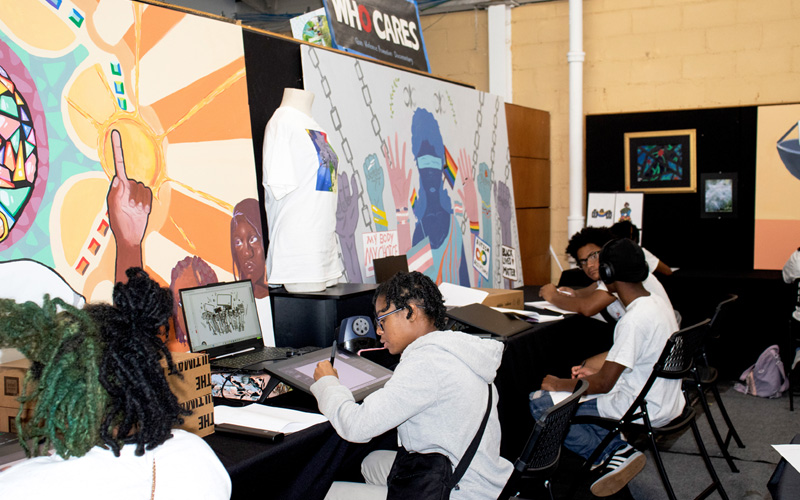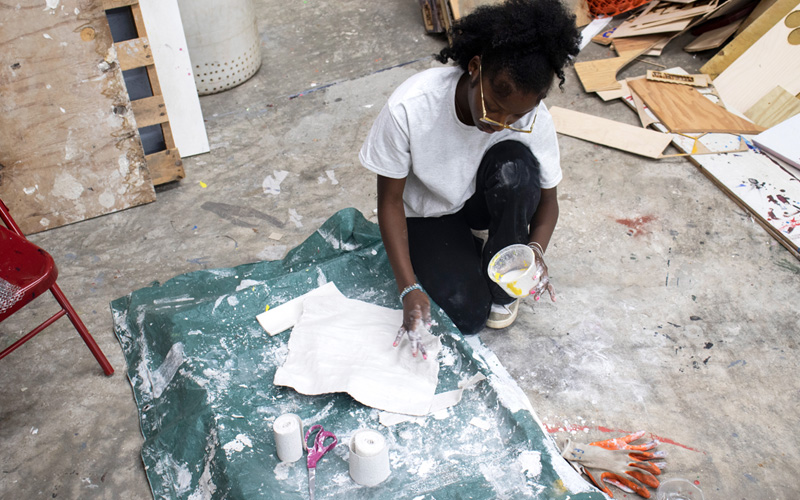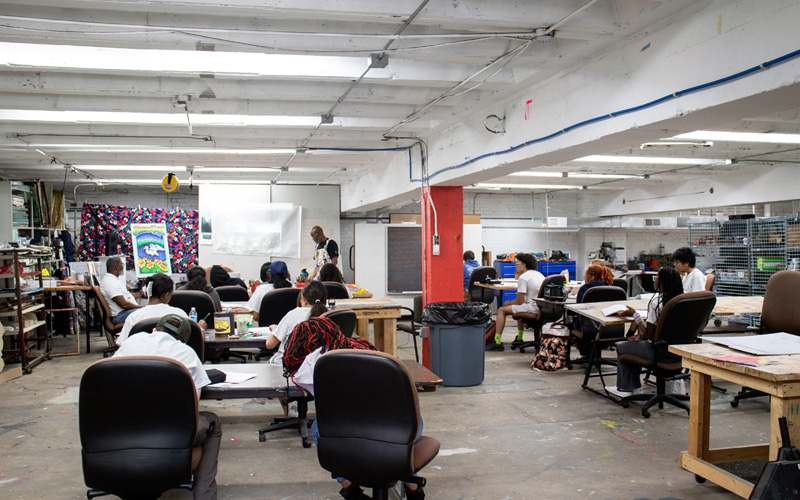By Kallie Cox
Nearly every day this summer, dozens of St. Louis teens are trading one classroom for another. Instead of sleeping in, playing video games, or going to the pool, they are choosing to wake up before breakfast to make their way to a building on the Delmar Loop and do what many say is impossible. They are learning to earn a living producing art, and are getting paid while they do it.
At RACSTL-funded St. Louis Artworks, apprentices ages 14-19 are paired with instructors who teach them not only how to hone their respective artistic mediums, but how to make a career from them. All apprentices are paid during the program, and they are provided with breakfast, lunch, and in many cases a pair of tennis shoes from one of the program’s many partners.
Fridays during the apprenticeship are dedicated to learning life and business skills, such as financial literacy and how to build a resume.
While the apprenticeship program operates all year in different sessions, this summer session is particularly impactful. The young artists are focusing on the 60th anniversary of Freedom Summer.

In 1964, civil rights organizations and activists — many of them students— organized to increase African American voter registration and knowledge of voter disenfranchisement in Mississippi. They were met with horrific violence and attacks from the Ku Klux Klan.
“It is believed that 1,062 people were arrested, 80 Freedom Summer workers were beaten, 37 churches were bombed or burned, 30 Black homes or businesses were bombed or burned, four civil rights workers were killed, and at least three Mississippi African Americans were murdered because of their involvement in this movement,” according to the National Archives.
Activists fought back with protests, freedom schools, and freedom libraries. Their advocacy later pressured President Lyndon B. Johnson to sign the Civil Rights Act of 1964, according to the National Archives. A year later, the Voting Rights Act passed, enforcing the 15th Amendment to the Constitution.
Over the summer, apprentices with Artworks will be creating murals, documentaries, sculptures, yard signs, and more honoring this legacy and relating it to the struggles they are observing today.
Jacqueline Dace, St. Louis Artworks’ executive director, says this session there are five artistic disciplines apprentices are learning. These are sculpture, art and technology, videography, art essentials, and signage where students design yard signs.
“The concepts that they are working on are concepts that were developed during Freedom Summer,” Dace explains. “So we’re teaching them ways in which they can think about democracy and that their vote matters. And particularly, how they themselves can find their voice and how they can express themselves.”
This is an especially important concept for the program considering its building is located on St. Louis’ racial dividing line, the Delmar Divide. The Delmar Divide separates north and south St. Louis and makes evident the racial divisions in the city that are still present even after the Jim Crow Era, as can be observed by this Rudin Center visualization.
“The idea is to at least plant a seed. We never know what it is that can alter the trajectory of their life,” Dace says.
Ronald Young, a retired Kirkwood school teacher who currently teaches painting with the program, is focused on finding a way to relate the meaning of Freedom Summer to his students and what it means to them.
Young was eight years old during Freedom Summer and says at the time, a lot of it went over his head.
“I’m of the opinion that you can teach the kids anything, but you have to figure out what they can identify with,” Young says.
To do this, Young began his class by talking about what it means in society if a person doesn’t know how to read, and what implications that could have on a person. And, he pointed to the book bans happening all over the nation and in the schools of some of the apprentices.
Young hopes during the apprenticeship, he can find a way to break through to his students and teach them to grasp history and how in some ways, it is repeating in their lives.

Alyssa Kent, 16, has been an apprentice since she turned 14 and is participating in this session’s sculpture program.
“I would say it’s very in-depth and very hands-on. Everyone is connected somehow,” Kent said of the program. “I love the idea of having like one central theme that we all are able to kind of interpret and take to like our own understanding and be able to present it at the end.”
Currently, she is learning the basics of sculpting, but by the end of the summer, she and her cohort will participate in a public art project in the city.
“We’ve been able to have a little background on the research and everything that went on during the Freedom Summer era. I would say it just emphasizes the impact of change and how important it is to speak out,” she says. “I think our sub-theme of finding your voice ties in really well as well. We’ve been able to interpret it in our own type of way, and I think that’s very important.”
In the Community for the Community
St. Louis Artworks was founded in 1995 and has since supported more than 3,600 apprentices. If you take a stroll on the Delmar Loop and keep an eye out as you explore the rest of the city, you’ll likely notice murals, painted crosswalks and planters, and other art produced by apprentices over the years.
“A lot of people realize that this is a place where their kids can grow and get to know who they are and know themselves. We want to make sure that the word gets out that we are in existence and that there are ways in which people can help us to help others,” Dace says. “Because that’s what we’re all about. Everything we do, we’re doing it for the kids.”
Apprentices with the program are given the opportunity to sell the art they create at the end of each session. Several apprentices who have graduated from the program have come back to teach, and others have gotten full-ride scholarships to Washington University, Yale, the University of Chicago, and other major universities.
The apprenticeship program is important not only for the education and resources it offers St. Louis teens, but because of what it means. Here, apprentices are given “permission,” to do art, Dace points out.
“Sometimes art is looked upon as a secondary skill set, especially now, when a lot of things are turning […] towards the technology portion, and you kind of look at art as something that is a bypass product,” she says. “We give them the permission to be themselves, the permission to think and to be within groups and networks with other like-minded individuals and say ‘art is okay.’”
The program receives support from the community in the form of grants and donations. St. Louis Artworks is a grantee of the Regional Arts Commission of St. Louis among other local non-profits. Dace notes the program also receives support from Delmar Mainstreet.
Dace says the program continues to need support from the community and encourages folks to commission art projects from apprentices, purchase their creations at community shows and at their building on Delmar, and notes that they can donate unused art supplies and funding to the program.
“We cannot exist in this world without art,” Dace says. “This is a place where we highlight art to the level that it should be recognized.”
Kallie Cox is a former staff writer at the Riverfront Times. They began writing freelance content for the Regional Arts Commission of St. Louis in June 2024.


Follow Us On Social Media